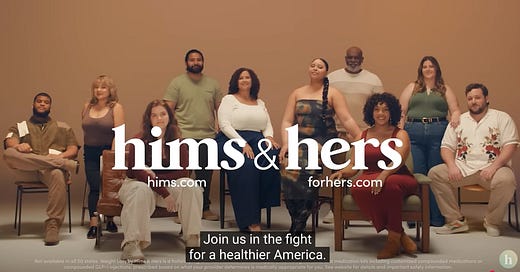Super Bowl weight loss drug ad controversy
If you watch any TV you’ve probably seen commercials for Hims & Hers products - messages making highfalutin claims without many details.
And then came the massive opportunity to buy time during the Super Bowl.
First, if you haven’t heard of GLP-1 drugs, it’s time to learn. (Because I may have one or two other GLP-1 articles later this week.) The Cleveland Clinic states:
GLP-1 agonists are a class of medications that mainly help manage blood sugar (glucose) levels in people with Type 2 diabetes. Some GLP-1 agonists can also help treat obesity.
GLP-1 agonists are most often injectable medications, meaning you inject a liquid medication with a needle and syringe. You give the shots in the fatty tissue just under your skin (subcutaneous injection). Areas of your body you can give the injections include your belly, outer thighs, upper buttocks and the backs of your arms.
These medications are relatively new. The U.S. Food and Drug Administration (FDA) approved the first GLP-1 agonist (exenatide) in 2005. Researchers are still learning about their other potential uses and benefits.
GLP-1 agonists alone can’t treat Type 2 diabetes or obesity. Both conditions require other treatment strategies, like lifestyle and dietary changes.
Now back to the Super Bowl.
Barron’s headline: A Super Bowl Ad Sparks Controversy and Signals a New Era in U.S. Health. Excerpts:
The battle over the weight-loss drug market will enter a new, politicized phase on Super Bowl Sunday, when telehealth company Hims & Hers airs a minute-long advertisement in one of the priciest ad blocks of the year. …
The Hims ad, posted in late January on YouTube, has drawn a concerned letter from two U.S. senators—one Republican and one Democrat—to the Food and Drug Administration. It points to a shift in the fight over knockoff GLP-1 weight-loss drugs, which have been legal while the branded versions remain in shortage.
That period of shortages is likely to end soon, posing a major threat to the telehealth companies that have rushed into the market. Hims sells a compounded version of semaglutide, which is the medicine Novo Nordisk sells under the brand name Wegovy. …
The future of Hims' GLP-1 offerings now depends largely on the FDA, and how it enforces the regulations around drug compounding. As Robert F. Kennedy, Jr. arrives at the U.S. Department of Health and Human Services, which houses the FDA, Hims has cast its cheaper weight-loss drugs as a MAHA-friendly answer to the healthcare system's high prices. …
The Hims ad is vague about the products the company is selling. The voice-over states that "Hims & Hers offers life-changing weight-loss medications" that are "doctor-trusted," but the voice-over doesn't include the words "semaglutide" or "GLP-1."
The ad doesn't list the risks or side effects of GLP-1 drugs.
FDA rules require that ads that make a claim about a drug's benefits need to include a statement of its risks. Under the regulations, ads that don't mention a specific drug don't need to include that statement of risks.
While the Hims ad doesn't name a drug, the video includes images of Hims-branded vials that look like the compounded semaglutide vials sold on Hims' website.
The New York Times headlined: Millions Will See This Super Bowl Ad. Health Experts (and Two Senators) Aren’t Pleased. Subhead: ”The spot makes lofty claims about weight-loss drugs offered by the telehealth company Hims & Hers, but says little about risks.” Excerpts:
These are compounded drugs, meaning they haven’t gone through the traditional approval process designed to safeguard against risks to consumers — a point the ad largely glosses over.
On Friday, Senators Richard Durbin, Democrat of Illinois, and Roger Marshall, Republican of Kansas, sent a letter to the acting head of the Food and Drug Administration saying the ad “risks misleading patients.
“Nowhere in this promotion is there any side-effect disclosure, risk or safety information as would be typically required in a pharmaceutical advertisement,” they wrote.
In a Northwestern University news release, two obesity experts weigh in on the debate:
“These drugs are not coming from a regulated manufacturer, so you don’t know who the manufacturer is, and the level of scrutiny in terms of practices compared to places that produce the FDA-approved medications is markedly different,” Dr. Justin Ryder said. “For instance, Eli Lilly and Novo Nordisk would immediately get shut down if there were impurities.”
The risks include side effects and long-term complications, Ryder said.
“We don’t have any idea of potency and efficacy of these drugs,” Dr. Veronica Johnson said. “We also don’t have any safety data. There are some reports that these may be marketed and not even been the advertised products."
This is one drug ad campaign that has drawn massive media criticism, with stories by USA Today, CNBC, Forbes, Fortune, FiercePharma, Bloomberg, Medical Economics, STAT News, Wall Street Journal and others.
The ad campaign is a high-profile, big bucks kiss-up to the new Administration and its MAHA promises. The tagline at the end of the commercial is:
Join us in the fight for a healthier America.
Join me later this week for more about the promotion of GLP-1 drugs and supplements.
Addendum on Feb. 11: For what it’s worth, a New York Times TV critic rated this commercial the worst of all 64 commercials shown during the Super Bowl. His analysis:
The telehealth company’s plug for its weight-loss services takes the form of a jangly attack on big pharma and corporate medicine. Confusing, unsettling and unconvincing.





